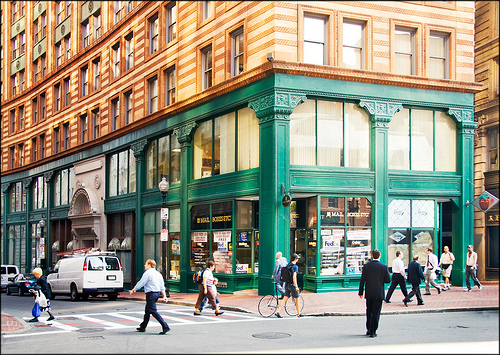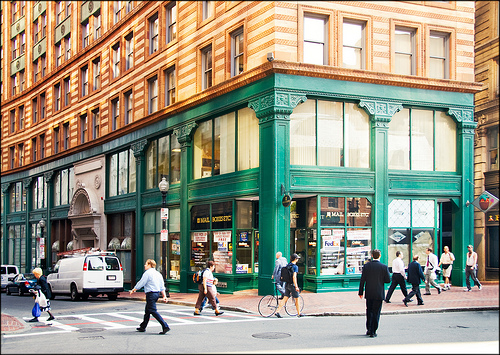You might not see much similarity between  More people walk to work in Boston than in any other city in the country.Photo: Steve MinorYolo County, Calif., with its open farmland and small cities, and the densely packed streets of New York City. But both are on the Natural Resource Defense Council’s list of “America’s Smartest Regions for Transportation.”
More people walk to work in Boston than in any other city in the country.Photo: Steve MinorYolo County, Calif., with its open farmland and small cities, and the densely packed streets of New York City. But both are on the Natural Resource Defense Council’s list of “America’s Smartest Regions for Transportation.”
The list is a result of a study done by the NRDC’s Smarter Cities Project, in collaboration with the Center for Neighborhood Technology:
The study… compares and profiles U.S. cities based on public transit availability and use; household automobile ownership and use; and innovative, sustainable and affordable transportation programs.
“Innovative transportation programs that deliver a variety mobility options including integrated bike paths, bus, rail, and even vanpools not only benefit the environment, but they also enrich urban life by making city attractions and neighborhoods more accessible,” says Deron Lovaas, director of Federal Transportation Policy at NRDC. “By improving regional transportation policies we boost local economies, reduce air pollution, enhance quality of life, and even benefit public health by making walking and biking safer and more enjoyable for commuters.”
Yolo County, which was recognized in the under-250,000 category, encompasses the town of Davis, since the 1960s one of the nation’s best places to ride a bicycle for transportation. The area also has an excellent bus system that runs on compressed natural gas. New York got the nod in the over-a-million division for having by far the highest percentage of commuters using transit (50 percent) as well as its ever-growing bike lane network (spearheaded by the intimidatingly awesome Janette Sadik-Khan).
Other nifty facts highlighted by the study:
- In Lincoln, Neb., low-income riders pay a mere $7.50 for unlimited bus rides all month long.
- In Jersey City, N.J. only 60 percent of residents own or have access to a car. More than 98 percent of households, a higher percentage than in anywhere else in the United States, have access to transportation, meaning that they are located within a quarter-mile of a bus stop or within a half-mile of a rail station.
- Chicago wants to be electric-vehicle-ready by 2012, with 280 electric vehicle charging stations throughout Chicago and its surrounding suburbs.
- In downtown Boston, around 65 percent of trips during peak hours are non-motorized; more people walk to work in Boston than anywhere else in the country.
- Philadelphia has selectively expanded the city’s public transit system in certain neighborhoods to increase residents’ access to fresh food.
- Boulder, Colo., has built paved pathways along Boulder Creek that allow walkers and bikers to travel up to 52 miles without ever having to cross traffic.
The full list of the smartest regions is below, with links to writeups of NRDC’s findings. Do you live in one of these places? Do you benefit from smarter transportation choices?
Large (population > 1 million)
- Boston, Mass./New Hampshire
- Chicago, Ill.
- New York, N.Y.
- Portland, Ore.
- Philadelphia, Penn./N.J.
- San Francisco, Calif.
- Washington, D.C./Md./Va./W.Va.
Medium (pop. between 250,000 – 1 million)
Small (pop. < 250,000)




